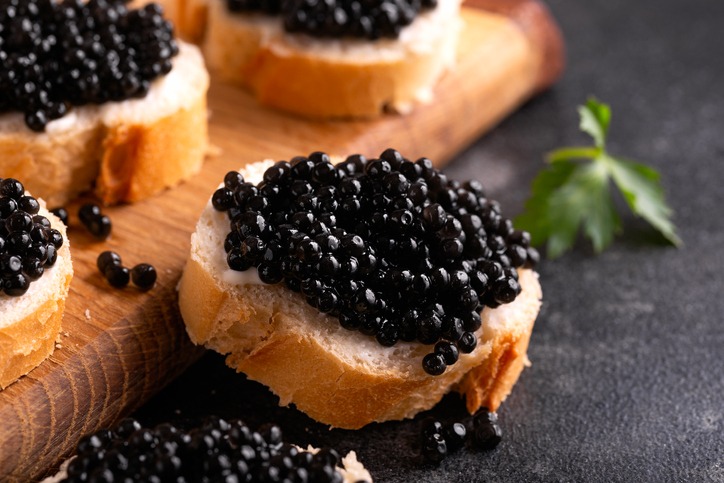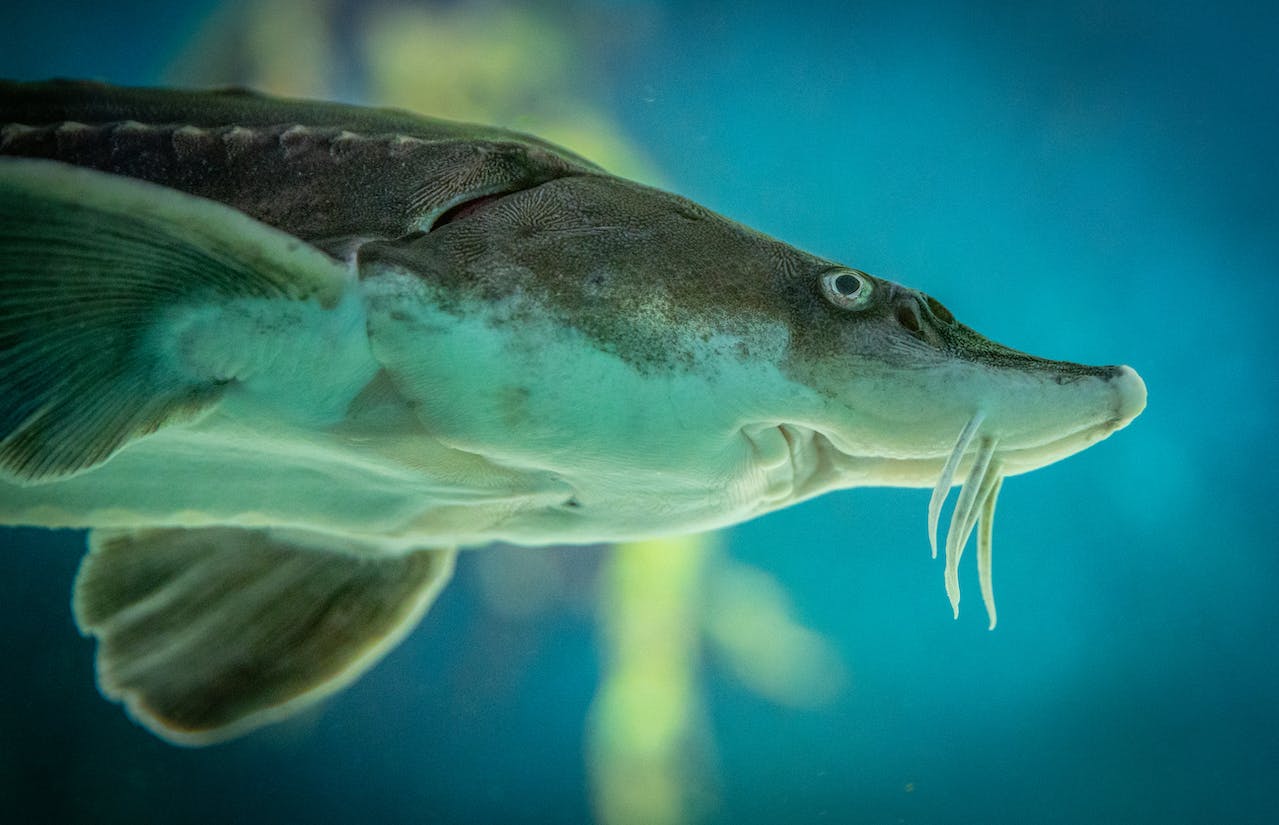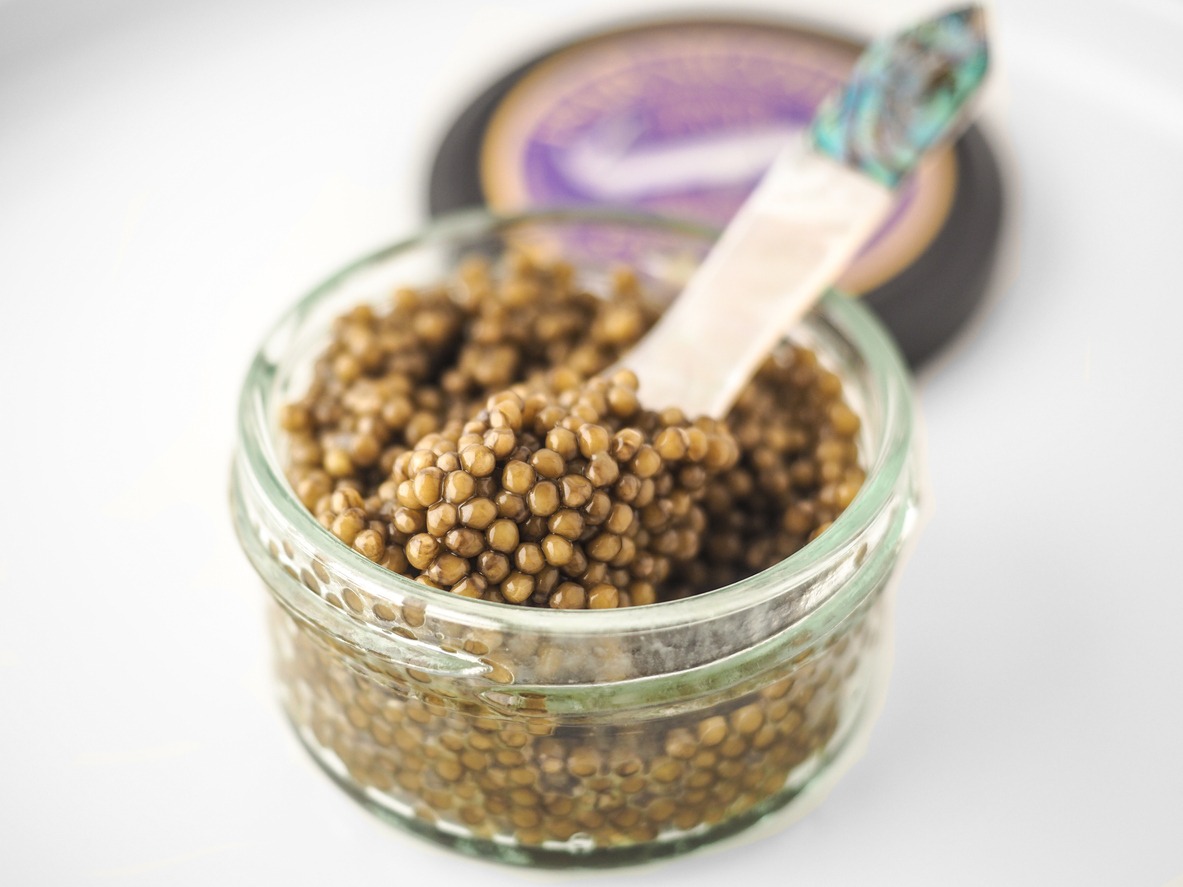Caviar, the esteemed delicacy derived from sturgeon roe, has long been celebrated in the culinary world for its unique taste and texture. Prized as a symbol of luxury and gastronomic finesse, caviar’s journey from the depths of the sea to the heights of gourmet dining is a tale of elegance and refinement. Caviar is often eaten raw as an appetizer and is considered a luxury good that can fetch high prices.
The Essence of Caviar
Caviar is traditionally sourced from the sturgeon fish found in the Black and Caspian seas. Due to overfishing concerns, global caviar production has expanded, embracing sustainable practices and new regions. It can be challenging to determine what type of caviar to buy for your next culinary adventure!
So what is Fish Roe?
Fish roe refers to the eggs or egg masses of fish and certain marine animals. It’s a term that encompasses a wide variety of eggs from different species, each with its own unique characteristics, culinary uses, and flavors.
- Broad Definition: Roe is the fully ripe internal egg masses in the ovaries of fish and certain marine animals, such as sea urchins and shrimp.
- Types: The term ‘roe’ covers a wide range of eggs, including those from salmon (often called red caviar), trout, lumpfish, flying fish (used in sushi), and more.
What are the different types of Sturgeon?
Sturgeon is a group of species of fish belonging to the family Acipenseridae, known for their long history and importance in the culinary world, particularly for producing caviar. Here’s an in-depth look at sturgeon:
Basic Characteristics
- Appearance: Sturgeons are large, elongated fish with scaleless, bony plates called scutes along their bodies. They have a distinctive appearance, including a long, pointed snout and a mouth located on the underside of the head, adapted for bottom-feeding.
- Size: Some species can grow to be quite large. The Beluga sturgeon, for instance, can reach over 20 feet in length and weigh over a ton, making it one of the largest freshwater fish.
Habitat and Distribution
- Habitat: Sturgeons are primarily found in subtropical, temperate, and sub-Arctic rivers, lakes, and coastlines. They are anadromous, meaning they migrate from saltwater to freshwater to spawn.
- Distribution: They are native to the Black, Caspian, and Adriatic seas, as well as the rivers and lakes of North America and Eurasia.
Species and Lifespan
- Variety: There are around 27 species of sturgeon. Some of the most well-known include the Beluga, Ossetra, and Sevruga sturgeons.
- Longevity: Sturgeons are known for their long lifespans, with some species living up to 100 years or more.
Caviar vs. Other Fish Roe
- Sturgeon Specialty: Not all fish roe qualifies as caviar; only the roe from sturgeon fish bears this prestigious title.
- Anadromous Nature: Sturgeons are unique, migrating between saltwater and freshwater environments.
- Size and Habitat: Sturgeons can grow significantly large, with some species native to both Eurasian regions and the Americas.
Variety: The Heart of Caviar’s Appeal
Caviar enthusiasts cherish the diversity of flavors and textures offered by different sturgeon species:
- Beluga Caviar: Renowned for its size and rarity, Beluga caviar, though often restricted, remains a symbol of opulence in the caviar world.
- Kaluga and Ossetra Caviars: Kaluga offers a comparable taste to Beluga, while Ossetra is celebrated for its nutty flavor profile.
- Sevruga and Sterlet Varieties: Known for their strong flavors and distinctive textures.
- Hackleback: A North American variety known for its mild and nutty taste.
Grading Caviar: A Mark of Quality
Caviar is graded based on the size, texture, and flavor of the eggs:
- Grade 1: Features firmer, larger eggs and is typically more expensive.
- Grade 2: Consists of softer, smaller eggs and is more affordable.
Beluga caviar ranges from pale silver-gray to dark gray. The color grading typically follows a scale where 000 indicates the lightest color, 00 is medium, and 0 is darker. Traditionally, lighter colors are more valued, though this is also a matter of personal preference. Beluga caviar is also famous for its large egg size. The eggs are graded based on their diameter and uniformity. Larger, more consistent eggs are often considered higher quality.
Golden caviar, also known as Almas caviar, holds a prestigious place in the world of gastronomy, known for its rarity, unique color, and exquisite flavor. Here is an in-depth look at this luxurious delicacy:
- Source: Golden caviar primarily comes from the rare Albino sturgeon, although not all Albino sturgeons produce golden roe. This type of sturgeon can be found in the Caspian Sea, mainly Iran, which is known for its caviar production.
- Rarity: The occurrence of golden caviar is extremely rare. It’s believed that only about 1 in 1,000 sturgeons produces this unique roe. The scarcity of golden caviar makes it one of the most expensive and sought-after types of caviar in the world.
Pasteurized vs. Unpasteurized Caviar
- Pasteurized Caviar: Offers a longer shelf life and reduced risk of foodborne illnesses.
- Unpasteurized Caviar: Preferred by connoisseurs for its superior flavor and texture.
Serving and Enjoying Caviar
The Ideal Caviar Experience
- Serving Method: Best enjoyed in its pure form, caviar should be presented on ice with non-metallic spoons to prevent altering its flavor.
- Accompaniments: Simple pairings like crackers, toast points, or blinis complement caviar without overshadowing its taste.
Caviar as a Garnish
- Culinary Uses: Caviar makes an exquisite garnish for a variety of dishes, adding a touch of elegance without the need for cooking.
The Taste Profile of Caviar
Caviar, renowned for its luxurious status in the culinary world, possesses a complex and nuanced taste profile that can vary significantly based on the type of sturgeon, the environment in which it was harvested, and the methods of processing. Here’s a deeper look into the taste profile of caviar:
General Flavor Characteristics
- Salty and Briny: Caviar is inherently salty due to the preservation process, but the level of saltiness can vary. The best caviar should not be overly salty but rather have a balanced brininess that enhances its natural flavors.
- Buttery and Creamy: High-quality caviar often has a rich, buttery flavor, contributing to a luxurious mouthfeel. This creaminess is more pronounced in certain types of caviar, like Beluga.
- Nutty Undertones: Many caviar varieties, such as Ossetra, are noted for their subtle nutty flavors, adding depth to the overall taste experience.
Texture
- Pop and Burst: One of the most distinctive features of caviar is its texture. The eggs should be firm enough to hold their shape but delicate enough to burst in the mouth, releasing their flavors.
- Smoothness: The eggs should feel smooth and not grainy. The sensation of the eggs gently popping is a hallmark of fresh, high-quality caviar.
Where to Source Caviar
Caviar can be found in gourmet markets or through specialized online retailers. Prices vary based on type and origin, and it’s essential to consider refrigeration needs, especially for unpasteurized varieties.
Storing Caviar
- Unpasteurized Caviar: Should be stored in the coldest part of the refrigerator and consumed within a few days of opening.
- Pasteurized Caviar: Has a longer shelf life and can be stored for several months.
Conclusion
Caviar, with its rich history and luxurious allure, remains a pinnacle of fine dining. Understanding its varieties, proper serving methods, and storage can enhance the experience, making every caviar indulgence a memorable one. Whether as a standalone treat or a sophisticated addition to a dish, caviar continues to captivate the palates of culinary enthusiasts worldwide.



